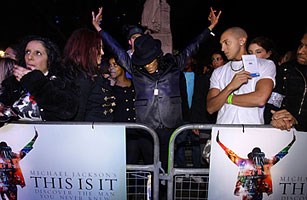
Fans gather in London's Leicester Square at the U.K. premiere of Michael Jackson's This Is It on Oct. 27, 2009
Death and resurrection. That's the scenario not just for gods but for pop stars who earn fans' ardor with an electrifying presence and their sympathy with very public private lives of addiction and misbehavior. The stars' talent makes them unique; their transgressions make them human. Michael Jackson, who died in June at age 50, outlived Edith Piaf and Judy Garland by three years, and Elvis by eight. (Forget Madonna — that woman is too smart to self-immolate.) Jackson's bizarre resculpting of his features, his litigious shenanigans with his youngest admirers, his obsession with being an eternal preadolescent, a petrified Peter Pan: all these eccentricities gave him an otherworldly cast. It took death to restore his standing as one-of-a-kind entertainer — to bring him back to life.
Jackson is hot again. His old albums — now sacred relics, for which the faithful did not pay so much as tithe — sold better after his death this summer than they had in this millennium. A poll of visitors to the Fandango website showed that the No. 1 movie costume for this weekend's Halloween revelers would be Michael Jackson. The singer, whose worldwide success was built on CDs and concerts, not movies, became his own fictional character. And like the runners-up — Wolverine from the X-Men films and the Twilight series' Edward — Jackson is a hero from the dark side.
But full redemption, not to mention true resurrection, requires a personal appearance. And on the 125th day he rose from the dead, at least on screen, with Michael Jackson's This Is It, a docu-musical record of the star's rehearsals for his comeback London concert series that was to begin in July. Sony, the music and movie conglomerate that has had a decades-long stake in Jackson's economic fortunes, shrouded the project in mystery until its premiere, which was held simultaneously on Tuesday night and Wednesday in 16 cities around the globe. (Sony took over all 13 auditoriums of the Regal E-Walk Theater on New York City's 42nd Street to show the movie to 3,200 invitees.) Many of the venues had a satellite feed from the Nokia Theater in Los Angeles, where director Kenny Ortega, who had also been in charge of the planned concert, greeted surviving Jackson brothers Jermaine, Marlon, Tito and Jackie.
The only pre-premiere insights to the film came from two people who had been close to Jackson. His father Joe told the British tabloid News of the World, "This movie features body doubles, no doubt about it." (Given Joe's wrangles with his family and with AEG, the concert's promoters, he may not be an unimpeachable source.) Michael's stalwart buddy Elizabeth Taylor, who attended an early screening last week, effusively tweeted that This Is It was "the single most brilliant piece of filmmaking I have ever seen." And she was in The Sandpiper.
So what is This Is It? A concert film without the concert. A backstage musical that takes place almost entirely onstage. A no-warts hagiography that still gets the audience closer to the real Michael Jackson — MJ the performer, that is — than anything in the man's avidly documented history. Wisely and decently ignoring the circumstances of his death and the circus that followed it, Ortega focuses on the re-creation of about a dozen Jackson standards for the concert. ("Beat It," "Billie Jean," "Wanna Be Startin' Somethin'," "Black and White" and "I'll Be There" are all here.) At times several takes of a song are edited into one performance; you know because Jackson is sporting different rehearsal clothes. The footage was shot so the star could study his work and that of his crew, thus it has the artlessness of visual stenography. The art is in what we're privileged to watch: a perfectionist who quietly pushes himself to prove he's still got it.